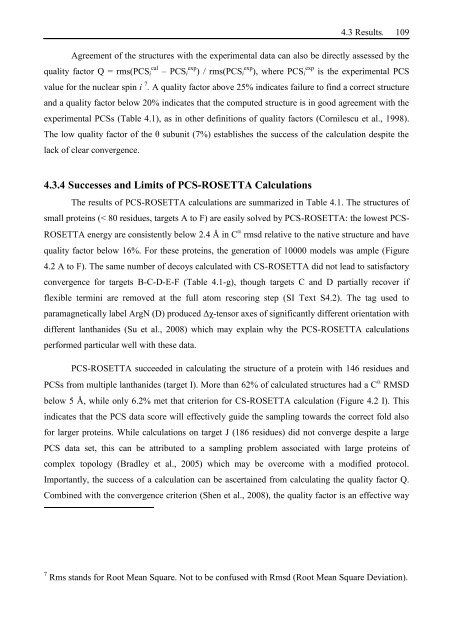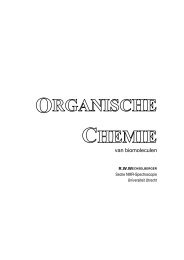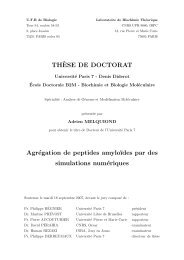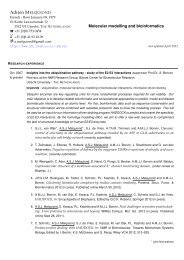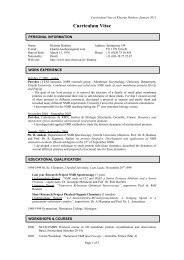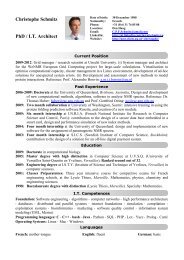Thesis Title: Subtitle - NMR Spectroscopy Research Group
Thesis Title: Subtitle - NMR Spectroscopy Research Group
Thesis Title: Subtitle - NMR Spectroscopy Research Group
You also want an ePaper? Increase the reach of your titles
YUMPU automatically turns print PDFs into web optimized ePapers that Google loves.
4.3 Results. 109<br />
Agreement of the structures with the experimental data can also be directly assessed by the<br />
quality factor Q = rms(PCSi cal – PCSi exp ) / rms(PCSi exp ), where PCSi exp is the experimental PCS<br />
value for the nuclear spin i 7 . A quality factor above 25% indicates failure to find a correct structure<br />
and a quality factor below 20% indicates that the computed structure is in good agreement with the<br />
experimental PCSs (Table 4.1), as in other definitions of quality factors (Cornilescu et al., 1998).<br />
The low quality factor of the θ subunit (7%) establishes the success of the calculation despite the<br />
lack of clear convergence.<br />
4.3.4 Successes and Limits of PCS-ROSETTA Calculations<br />
The results of PCS-ROSETTA calculations are summarized in Table 4.1. The structures of<br />
small proteins (< 80 residues, targets A to F) are easily solved by PCS-ROSETTA: the lowest PCS-<br />
ROSETTA energy are consistently below 2.4 Å in C rmsd relative to the native structure and have<br />
quality factor below 16%. For these proteins, the generation of 10000 models was ample (Figure<br />
4.2 A to F). The same number of decoys calculated with CS-ROSETTA did not lead to satisfactory<br />
convergence for targets B-C-D-E-F (Table 4.1-g), though targets C and D partially recover if<br />
flexible termini are removed at the full atom rescoring step (SI Text S4.2). The tag used to<br />
paramagnetically label ArgN (D) produced Δχ-tensor axes of significantly different orientation with<br />
different lanthanides (Su et al., 2008) which may explain why the PCS-ROSETTA calculations<br />
performed particular well with these data.<br />
PCS-ROSETTA succeeded in calculating the structure of a protein with 146 residues and<br />
PCSs from multiple lanthanides (target I). More than 62% of calculated structures had a C RMSD<br />
below 5 Å, while only 6.2% met that criterion for CS-ROSETTA calculation (Figure 4.2 I). This<br />
indicates that the PCS data score will effectively guide the sampling towards the correct fold also<br />
for larger proteins. While calculations on target J (186 residues) did not converge despite a large<br />
PCS data set, this can be attributed to a sampling problem associated with large proteins of<br />
complex topology (Bradley et al., 2005) which may be overcome with a modified protocol.<br />
Importantly, the success of a calculation can be ascertained from calculating the quality factor Q.<br />
Combined with the convergence criterion (Shen et al., 2008), the quality factor is an effective way<br />
7 Rms stands for Root Mean Square. Not to be confused with Rmsd (Root Mean Square Deviation).


